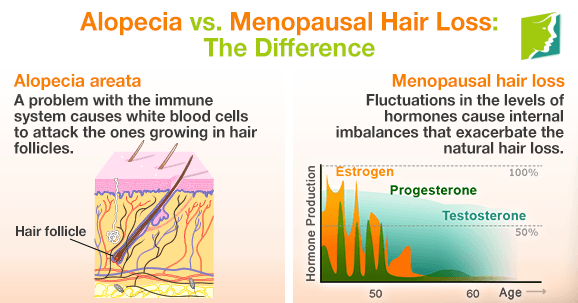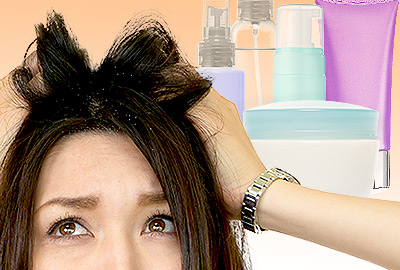Many women evaluate their beauty by the appearance of their hair. In a recent survey, the majority of female participants identified with the idea that if their hair looks good, they feel attractive, regardless of the rest of their appearance. It's not surprising, then, that hair loss can cause real distress. The most common causes of this in females are either alopecia areata or menopause.

Causes
Unlike menopausal hair loss, alopecia areata can occur at any age. The condition is thought to be a problem with the immune system, most likely hereditary. This condition causes white blood cells to attack the ones growing in hair follicles. Eventually, follicle cells begin shrinking, and hair production slows. This can cause hair from the scalp, eyelashes, eyebrows, and body to fall out, resulting in the occurrence of bald patches or total baldness.
Menopausal hair loss occurs when a woman is in her forties and early fifties, in a phase known as perimenopause. The hormones estrogen, progesterone, and testosterone are known to influence healthy hair growth, though the exact role they play is not fully understood. Perimenopausal fluctuations in the levels of these hormones cause internal imbalances that exacerbate the natural hair loss that occurs as a symptom of aging. This is often referred to as female-pattern baldness.
Effects
Total or near-baldness in menopausal hair loss is extremely rare. Hair is likely to become thinner on the top of the head, more brittle, or at most, to develop small patches of baldness.In extreme cases, all body hair may fall out and never grow back. However, in cases of alopecia areata, it is more common to suffer from temporary periods of near-total baldness or more noticeable bald patches. In addition, people with alopecia areata may experience hair loss and regrowth in phases throughout their lives, because the stem cells that provide hair follicles with new cells are not affected by white blood cell attacks. In some instances, hair may fall out once and then regrow fully.
Influences
Stress is an exacerbating factor. Problematically, the distressing nature of the symptom can contribute to stress levels and thereby intensify hair loss. In cases of menopausal hair loss, other menopause symptoms, such as hot flashes, mood swings, and fatigue.
Treatment Options
Though research to discover a cure for alopecia areata is underway, it remains inconclusive. There are many natural treatments to stimulate hair regrowth, but there is no guarantee that new hair will not fall under attack from white blood cells and subsequently fall out.
Using natural remedies to stimulate hair regrowth is usually more successful in cases of menopausal hair loss. Increasing iron intake is often effective, as iron functions primarily as a carrier of oxygen in the bloodstream.
Therefore, eating red meat, fish, nuts, and legumes could improve blood circulation to the hair follicles and stimulate regrowth. Consuming more biotin - a nutrient found in chard, lettuce, and tomatoes - may also enhance hair growth.
When dealing with hair loss, it's only natural to feel self-conscious or upset. While there may not be a cure for hair loss, there are always ways of disguising its effects. You may want to consider investing in a wig, hat, or colorful headscarf to mask any thinning or bald patches. Emphasizing another part of your body that you're proud of can also help; show off your legs, your waist, or highlight your eyes or lips with makeup to regain your confidence after hair loss.
Sources
- McKinley Health Center. (2010). Dietary Sources of Iron. Retrieved May 8, 2014, from http://www.mckinley.illinois.edu/handouts/dietary_sources_iron.html
- National Health Service UK. (2012). Alopecia. Retrieved May 8, 2014, from http://www.nhs.uk/conditions/Hair-loss/Pages/Introduction.aspx
- National Health Service UK. (2012). Hair loss - Causes. Retrieved May 8, 2014, from http://www.nhs.uk/Conditions/Hair-loss/Pages/Causes.aspx
- National Health Service UK. (2013). Hair loss - Treatment. Retrieved May 8, 2014, from http://www.nhs.uk/Conditions/Hair-loss/Pages/Treatment.aspx
- National Institutes of Health. (2014). Female pattern baldness: MedlinePlus Medical Encyclopedia. Retrieved May 8, 2014, from http://www.nlm.nih.gov/medlineplus/ency/article/001173.htm
- Park, S., Na, S., Kim, J., Cho, S. & Lee, J.(2013). Iron plays a certain role in patterned hair loss. Journal of Korean Medical Science, 28(6), 934-938. Retrieved May 8, 2014, from http://www.ncbi.nlm.nih.gov/pubmed/23772161
- Riedel-Baima, B. & Riedel, A. (2008). Female pattern baldness may be triggered by low oestrogen to androgen ratio. Endocrine Regulations, 42(1), 13-16. Retrieved from http://www.ncbi.nlm.nih.gov/pubmed/18333699
- University of Maryland. (2013) Alopecia. Retrieved May 8, 2014, from http://umm.edu/health/medical/altmed/condition/alopecia



